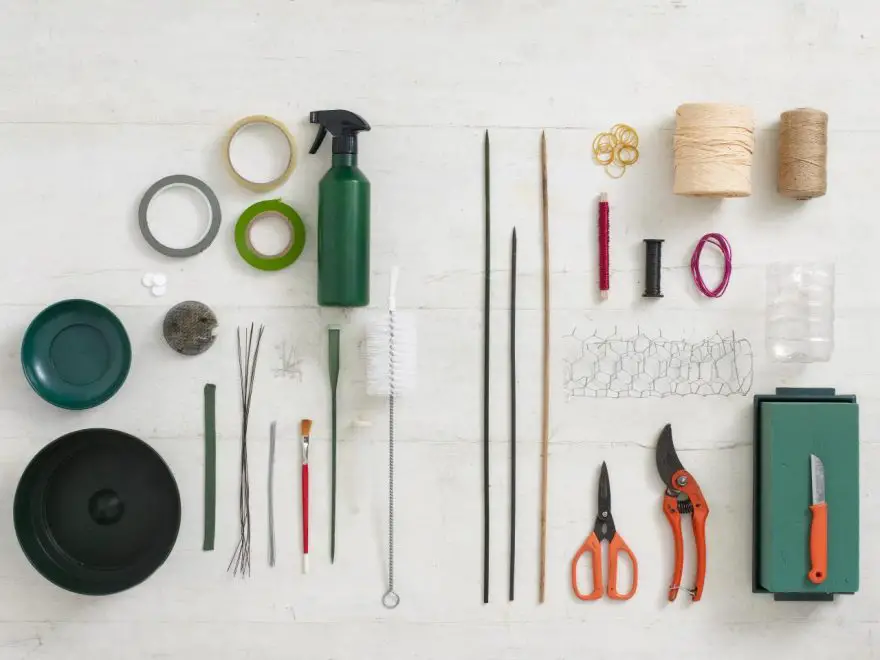Following are major Equipment and material required for flower arrangement:-
- 1. Mechanics
- 2. Equipment
- 3. Containers
- 4. Bases
- 5. Accessories
- 6. Plant material
- 7. Support
MECHANICS
These are items used to keep flowers, foliage, and stems in place within the container. Mechanics must be fixed securely and should be hidden from view.
Examples – florists’ foam (oasis), pin holders (Japanese term – kenzan), chicken wire, prong, adhesive clay and tape, florist cone.
- Floral foam, also called oasis, is a cellular plastic material, available in two types – green foam and brown/grey foam.
- Pin-holders also called kenzan or needle-point holders, is a series of sharply pointed pins are firmly held in a solid lead base, to hold thick and heavy stems securely by impaling them on the pins.
- Chicken wire, also called ‘wire mesh’ or ‘wire netting’, is a fine- gauge wire used to cover floral foam blocks in large displays.
- Prong is the simplest type of floral foam anchor. It is a small plastic disc with four vertical prongs. The base of the prong is attached to the container with adhesive clay and the floral foam is pressed down onto the prongs.
- Florist’s cone also called a ‘flower tube’ or ‘flower funnel’. It acts like a miniature vase. It is used in large arrangements, where foliage or flowers need to be placed above their stem height.
EQUIPMENT
This includes tools used to ensure that a satisfactory arrangement of plant material is created within the container. Examples – bucket, scissors, knife, watering can, mister, wire cutter, cocktail sticks, turn, wire, floral tape, candle holder, cut flower preservatives, and secateurs.
- Mister is a hand-held spray bottle to produce a fine mist of water droplets to keep an arrangement look fresh in warm weather.
- Secateurs are used to cut through thick and woody stems.
- Cocktail sticks or a toothpick is used to make holes in florists’ foam for a soft stem of a flower.
- Cut-flower preservatives is a bactericide, available in powder or liquid form, to prevent slime and smell from developing in the vase water, plus sugar to prolong the life of fresh flowers. A preservative can be made in-house by adding 3 teaspoons of sugar and 1 drop of bleach to half a litre of water.
CONTAINERS
These are receptacles that hold the flower arrangement. They may or may not be hidden by the plant material. The container must be waterproof and neutral colours such as soft grey, dull brown, offwhite, or earth colours are most suitable because they are inconspicuous and do not detract attention from flowers displayed. Theme and simplicity should be kept in mind while choosing the design of the container. Example – vases and jugs, basket, bowls and trays, wreath frame etc.
BASES
An object that is placed underneath the container to protect the surface of the support and/or to add to the beauty of the display is called a base. Example – table mat, tree section, wood base, stone base, and oriental base.
SUPPORT
This refers to the structure on which the container stands. Example – tables, sideboards, alcoves, and shelves.
PLANT MATERIALS
These can be divided into 3 basic types
a) Flowers ( dominant/ focal/ point material) – This consists of bold flowers or clusters of small showy blooms. The dominant material provides a centre of interest. Example – Gerbera, Chrysanthemum, lilies, Anthurium, Tulips, Poppies, Roses, Dahlias, and Daffodils.
b) Fillers ( secondary material) – This consists of smaller flowers and all sorts of leaves and foliage that are used to cover the mechanics and edges of the container and also provide added interest and colour to the display. Example – Asters, Ivy, Button Chrysanthemum, Carnations, Gypsophila (Baby’s breath), Limonium and Marguerites.
c) Foliages ( line material ) – This consists of tall stems, flowering spikes, or bold leaves that are used to create the basic framework or skeleton. This lining material may be straight or curved and it sets the height and width of the finished arrangement. Examples – Gladioli, birds of paradise, goldenrods, larkspur, asparagus ferns, palms, tuberoses, and Peruvian lilies.
ACCESSORIES
These are non-plant materials included in or placed alongside the arrangement.Their purpose is generally decorative but could be functional at times. Accessories are added to the design for extra interest or to ‘stretch’ the flowers when they are in short supply. Example – miniature dolls, hats, ribbons, beads, painted wire, wooden fruit shapes, silk flowers and foliage, candles, driftwood, shells, idols, interesting pebbles etc.
